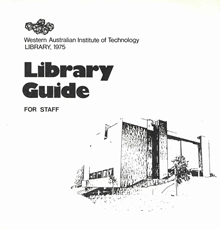
Library education (reader education)
Initially, the objective of the embryonic reader education program was to assist students newly out of secondary school to use a large tertiary library for the purposes of independent enquiry and learning.
Encouragingly, WAIT Directorate decided early on that the Library should have access to all first year students for a minimum of one hour in normal class time. However library staff still had to negotiate the scheduling of this access with individual academic departments.
By 1972, significant progress had been made in advancing this large scale program and Library staff were routinely presenting orientation courses of between one and four hours to undergraduates to help them build the skills needed for course-related research.
In 1979, Library staff undertook 425 hours of teaching spread across 56 reader education courses which reached some 3 500 students. Total WAIT student enrolment at that time numbered around 12 000.
Library staff also provided assistance to academic staff in the compilation of reading lists for students undertaking particular courses and of subject bibliographies (lists of books, articles, etc relevant to students’ disciplines).
Over the next few years, the inclusion of the program in the teaching schedule meant that virtually complete coverage was achieved. Allen saw this as testimony to the determination and persuasiveness of the relevant library staff, led by Public Services Librarian Andrew White, who came to be recognised Australia-wide as one of the leading experts in the area of user education in tertiary libraries.32
White saw the key benefits as being the close cooperation encouraged between librarians and teachers, the direct relevance of the instruction for students in their specific units of study, and the motivational effect on students of including an assessment and feedback component in the classes. 33
 This booklet from 1974 helped readers find resources in the Education Resources Information Collection (ERIC) at the Library.
This booklet from 1974 helped readers find resources in the Education Resources Information Collection (ERIC) at the Library.
 Library guides, like this 1975 guide for staff, were regularly updated and reprinted.
Library guides, like this 1975 guide for staff, were regularly updated and reprinted.